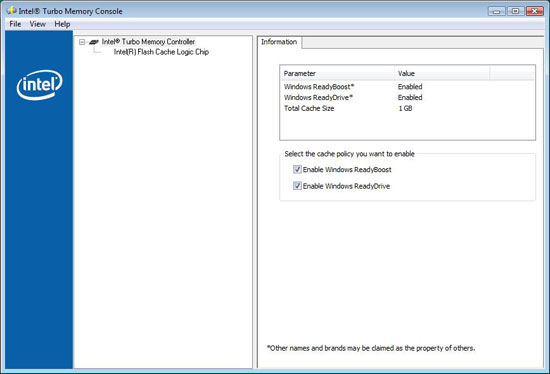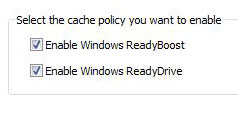Investigating Intel's Turbo Memory: Does it really work?
by Anand Lal Shimpi on June 19, 2007 3:39 PM EST- Posted in
- Laptops
Problem 1: A Poorly Written Control Panel
Intel's Turbo Memory requires a driver be installed in order to enable the technology, but the driver Intel provides is a bit finicky in operation. Installing the driver works like you would expect it to, you install the driver and Vista asks to be rebooted; when Vista comes back up is where the situation has to be handled differently.
Vista must be rebooted a second time in order for Turbo Memory to be completely enabled. Intel claims the second reboot is a Microsoft issue and Microsoft itself generally won't tell us about what Vista is doing under the hood so we're left in the dark here.
After the second reboot, you aren't in the clear yet. Vista needs several more reboots (with extended periods of idle time between reboots) to recognize that Turbo Memory is there and operational, and according to Intel, it needs to "learn" how to use the ReadyDrive cache. Once again, we'd love to explain the nuts and bolts of why this is necessary but sadly much of Vista remains a black box to us.

If you follow all the instructions, reboot enough times and please the NAND Flash Gods, Intel's Turbo Memory will be enabled. You'll even have a nice little control panel you can use to confirm that it is enabled, but here is where things can go wrong once more.
The control panel has two check boxes that appear to be used to "select the cache policy you want to enable":

We originally made the mistake of trusting what the console said; don't touch these boxes and you'll be fine
By no means should you check or uncheck either of these boxes. According to Intel, they are not meant to be used to enable/disable Turbo Memory, and tinkering with them may enable or disable the technology with no way of confirming what has happened. Intel went as far as to say that if we touched anything on this page that we shouldn't trust what the control panel told us because it may not be correct; the control panel should simply be used as a visual tool to confirm that ReadyBoost and ReadyDrive are enabled. The control panel will tell you the truth about whether or not the RB/RD caches are enabled, so long as you don't touch any of the buttons.
We rebooted as much as we needed to (7 times total including the reboot requested by the driver install), left the computer idle between each reboot for 10 minutes, and stayed far away from the tempting checkboxes in the Turbo Memory Console; after all of that, we had Turbo Memory enabled with 100% certainty and we could begin our testing.










31 Comments
View All Comments
SilthDraeth - Wednesday, June 20, 2007 - link
NVM. I think I understand. The "Windows XP startup" is a test that "PCMark '05" runs.Thanks.
DigitalFreak - Wednesday, June 20, 2007 - link
They really should have dedicated the entire 1GB to ReadyDrive instead of splitting it.Nighteye2 - Tuesday, June 19, 2007 - link
I miss the test of readyboost at 2GB of memory. Does the technology still improve performance even when you have a lot of memory?Azsen - Tuesday, June 19, 2007 - link
It does sound like Microsoft need to rework the code for Readyboost and Turbo memory to make use of the extra flash memory more. From the benchmarks it doesn't look like it's being used to its full potential at all. They also need to rework the code so it's enabled after one reboot, not a whole lot of reboots. That's shocking.androticus - Tuesday, June 19, 2007 - link
A technology so persnickety, complicated, and without any significant real world benefits and often just more slowdowns is a total loser!And 512M of cache supposed to in any way adequately cover the huge hard disks of today? Including swap file?
yzkbug - Tuesday, June 19, 2007 - link
My take is to go with a flash-based hard-drive (when prices come down). It should give all benefits that the Turbo Memory was supposed to bring: drain less power and have quick random seeks.Roy2001 - Tuesday, June 19, 2007 - link
Agree.Pirks - Tuesday, June 19, 2007 - link
this poor soul together with his lover beenthere would just jump from joy reading this article. expect usual assortment of MICROSUCKS and INTEL SCAM and shit like that.what's the most funny here is that this is the only case where he would be pretty close to truth, ain't that amusing huh
pnyffeler - Tuesday, June 19, 2007 - link
While I may agree that the impact is minimal, you still have to tip your hat to Intel. Power saving in laptops is probably not going to see revolutionary changes. While 5-10% may not seem like much, it's better than not having it.Besides, what's to say that the impact might be much larger with a larger cache. You could argue that at the extreme end, the longest the battery life could be extended to would be if there was no hard drive at all, just the flash drive. If that were true, then the max the battery life could be under this scheme is the battery life with only a flash drive. How does that compare to these numbers?
And finally, what gives with only 1 GB of flash? If an iPod with 8GB of flash costs $250, I'd pay that much for 8 GB in my laptop if it would make a big enough difference.
TA152H - Tuesday, June 19, 2007 - link
Anand,You're missing something quite significant on ReadyBoost. You talk about adding another gigabyte of memory like there is only a financial cost involved, but this isn't so. If you add more memory to laptop, you use more power, emit more heat, etc... If you can get similar performance for a part that uses less power (it would be interested to know how much power it does use), you extend battery life as well as save money, and don't suffer a huge performance penalty. So, it's actually quite useful.